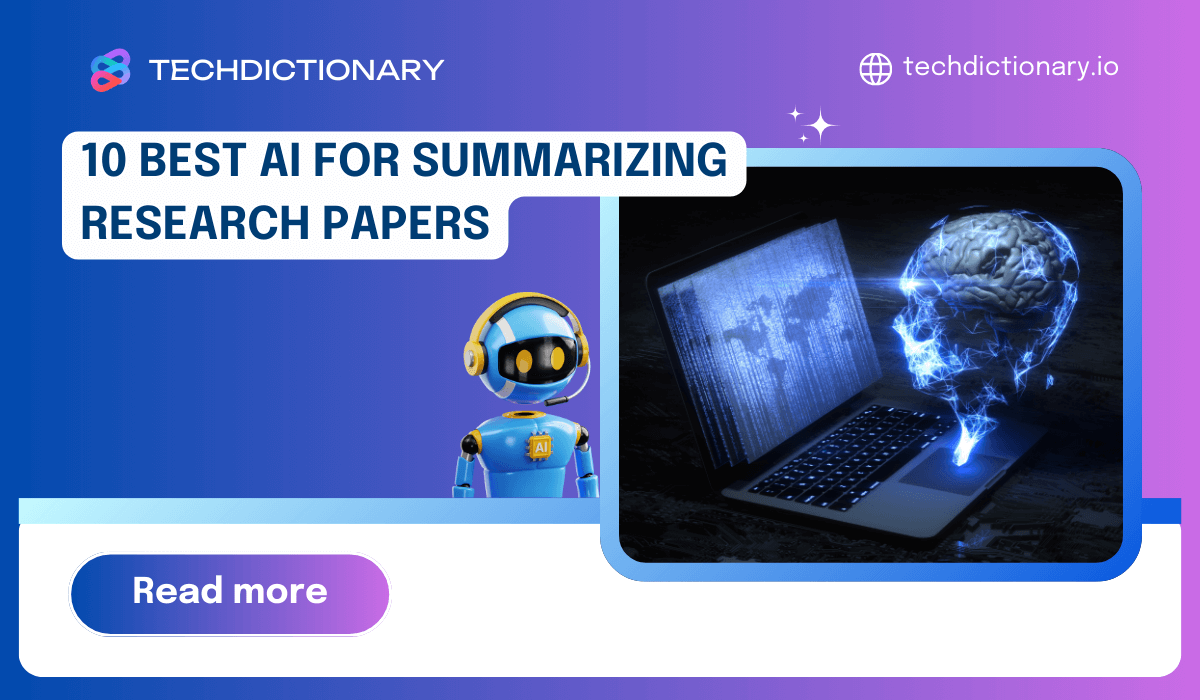Heads up! The article includes affiliate links. If you click and purchase, we may receive an affiliate commission at no extra cost to you. Check our Affiliate Disclaimer.
Have you ever felt overwhelmed by a lengthy 30-page research paper, wishing it could be condensed into something simpler? As frequent readers of academic papers, we understand that it can be time-consuming and often frustrating.
The good news is that AI tools for summarizing research papers are available to help. These tools can quickly transform complex papers into clear and concise summaries, saving you hours of reading time.
In this guide, we will share the nine best AI research paper summarizers that we have tested. These tools will help you grasp complex research more quickly and focus on what truly matters.
What Are AI Research Paper Summarizers?
Definition
An AI research paper summarizer is a tool that uses artificial intelligence to quickly turn academic papers into clear, easy-to-read summaries. It processes the information contained in scholarly papers and determines the key concepts, methodologies, and findings. Subsequently, this provides easier comprehension of complex research.
At TechDictionary, we believe the right AI tools for summarizing research papers can help students and academics save time, reduce effort, and boost both focus and productivity.
Why You Need Them?
AI summarizers empower you to cut through the clutter of academic research and not only save time but also remain educated with appropriate findings.
- Time saving: Get the gist of large-scale research in a fraction of the time instead of reading all of it.
- Increased output: Use the time saved for other required projects or research endeavors.
- Increased accessibility: Help cut through complicated verbiage to gain a better understanding of research.
10 Best AI for Summarizing Research Papers in 2025
AI-powered summarizing tools make it easier than ever to pull out key ideas from research papers in just minutes. This list of the top ten AI tools for summarizing research articles can help you work more efficiently, remain organized, and save time.
Otio
Otio is a one-stop shop for more effective research. It offers AI notes as well as the ability to chat with your documents or write and assist you as you formulate your draft. It essentially brings you from the literature review to the draft and all the steps in between.
Key Features:
- Chat Directly With Your Documents: Upload your research articles in PDF form and ask in a conversational style; Otio pulls answers straight from the document and responds to your prompts.
- AI-Generated Notes: If you read something complicated and don’t want to take notes, no problem; Otio will give you notes in an organized fashion.
- Topic-Focused Summarization: Receive summaries that only relate to your topic, keywords, or research questions; there’s no need to sift through irrelevant information.
- Draft Assistance: Otio can support you beyond summarizing by assisting in the drafting process, making it helpful for both research and writing tasks.
- Smart Document History: Access your articles and conversations uploaded any time from the history feature without having to start from scratch.
| Pros |
Cons |
| ✅ Increases productivity
✅ Supports multiple formats
✅ User-friendly interface
✅ Facilitates real-time collaboration |
❌ AI quality may vary
❌ Learning curve for new users
❌ Privacy concerns |
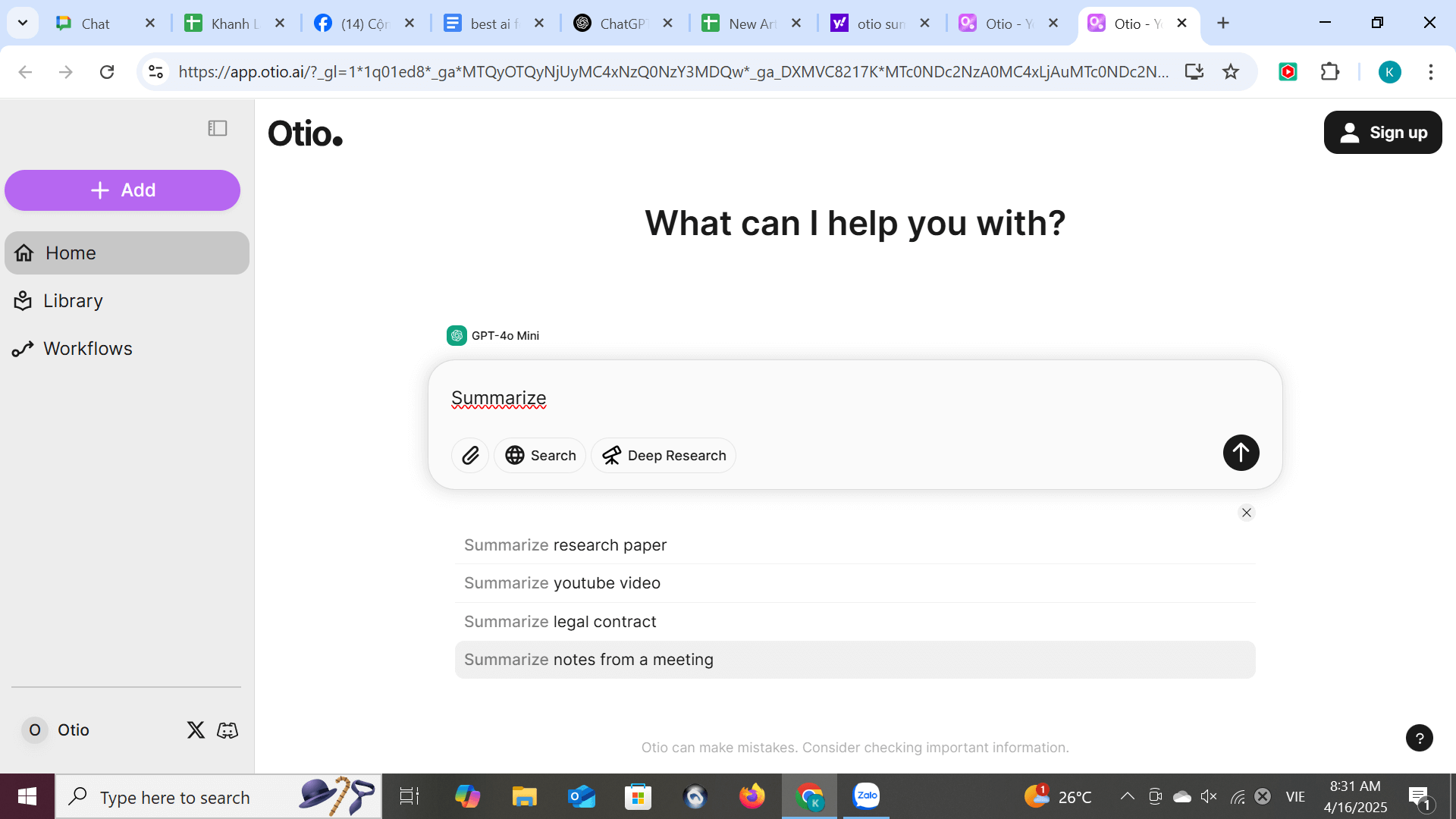
Otio Summarizing AI Tool
PDF.ai
PDF.ai specializes in summarizing long-form content into bite-sized versions, so you can spend less time comprehending dense works. PDF.ai is the best AI choice for summarizing research papers if you’re looking for one that works with PDF documents.
Key Features:
- Text Summarization: Automatically condenses long documents into clear, concise summaries.
- Searchable PDF Integration: Easily handles PDFs, making research more efficient.
- Highlighting Key Points: Extracts and emphasizes essential sections of the text.
- Multilingual Support: Summarizes papers in various languages, broadening its usability
| Pros |
Cons |
| ✅ Interactive chat interface
✅ Provides source references
✅ Strong data privacy and security
✅ Multilingual capability |
❌ Limited free tier
❌ Generic example questions |
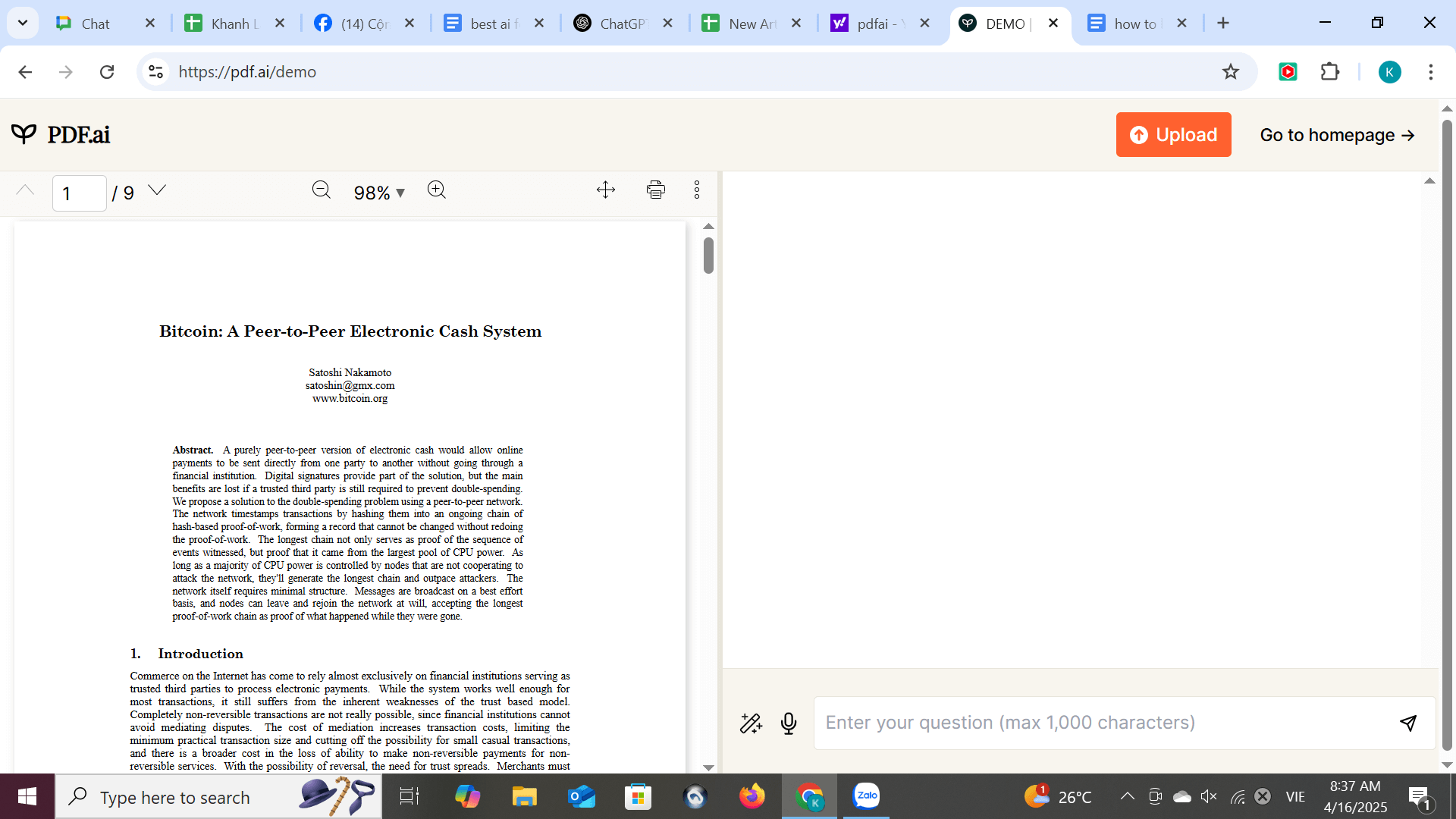
PDF.ai Document Tool
Sharly AI
Sharly AI offers an intuitive interface for document summarization, supports multiple input file types, and generates quick summaries via GPT-4. When it comes to speed and functionality, this is definitely one of the best AIs for summarizing documents.
Key Features:
- One-Click Summarization: Sharly AI has a very sleek and simplistic approach to summarizing. You upload your research paper, and with just one click, the AI generates important points and main themes—everything necessary for a student or professional who wants to get to the point.
- Q&A Mode: After summarizing, the chat mode allows you to further engage with the document you uploaded. You can ask “What is the conclusion?” or “Summarize the second paragraph,” and it will answer you in real time. If you’re trying to locate specific information without rereading the whole article, this is an excellent option.
- Compatible with Various Document Types: Sharly AI accepts various file types—from PDFs to DOCX to even web links—meaning you can summarize research articles, research papers, and published articles online without needing to copy and paste.
- Easy to Operate: No downloads. No prior learning necessary. Sharly AI is very minimalist in its operation, and anyone can start summarizing within minutes, whether they’re technologically savvy or not.
| Pros |
Cons |
| ✅ Saves time with quick summaries
✅ Provides critiques and insights
✅ Simplifies complex information
✅ Unlimited document uploads
✅ User-friendly interface
✅ Supports multiple languages
✅ No need for additional software |
❌ Occasionally gives inaccurate answers
❌ Weak data security
❌ Upload errors can occur
❌ No support for Excel or image text
❌ Multilingual responses lack nuance |

Sharly AI Website
AI Summarizer
AI Summarizer distinguishes itself by distilling complicated knowledge into simple, non-technical language, making it appropriate for busy readers. This is one of the best AI tools for summarizing research papers for newbies.
Key Features:
- Text Entry Options: Users can either paste their content or supply a URL, and the summarizer does the rest, taking it from there to extract and summarize on its own.
- Short, Medium, Long Options: Users can ask for a short summary, a medium summary, or a long summary to receive exactly what’s needed in length.
- Language Options: This tool works in 20+ languages, from English to Spanish, to French, and even German, Chinese, meaning it’s a tool for all.
- AI Technology: This summarizer uses deep natural language AI processing to ensure that the summary retains the original meaning and pieces of important information.
- Data Privacy: Ensures user content is not stored, prioritizing privacy and security
| Pros |
Cons |
| ✅ Saves time with quick summaries |
❌ Misses subtle details |
| ✅ Improves comprehension |
❌ Limited advanced features |
| ✅ Multilingual support |
❌ Can be expensive |
| ✅ Customizable output |
❌ Sometimes inaccurate |
| ✅ Increases efficiency |
❌ Requires human review |
| ✅ Enhances learning |
|
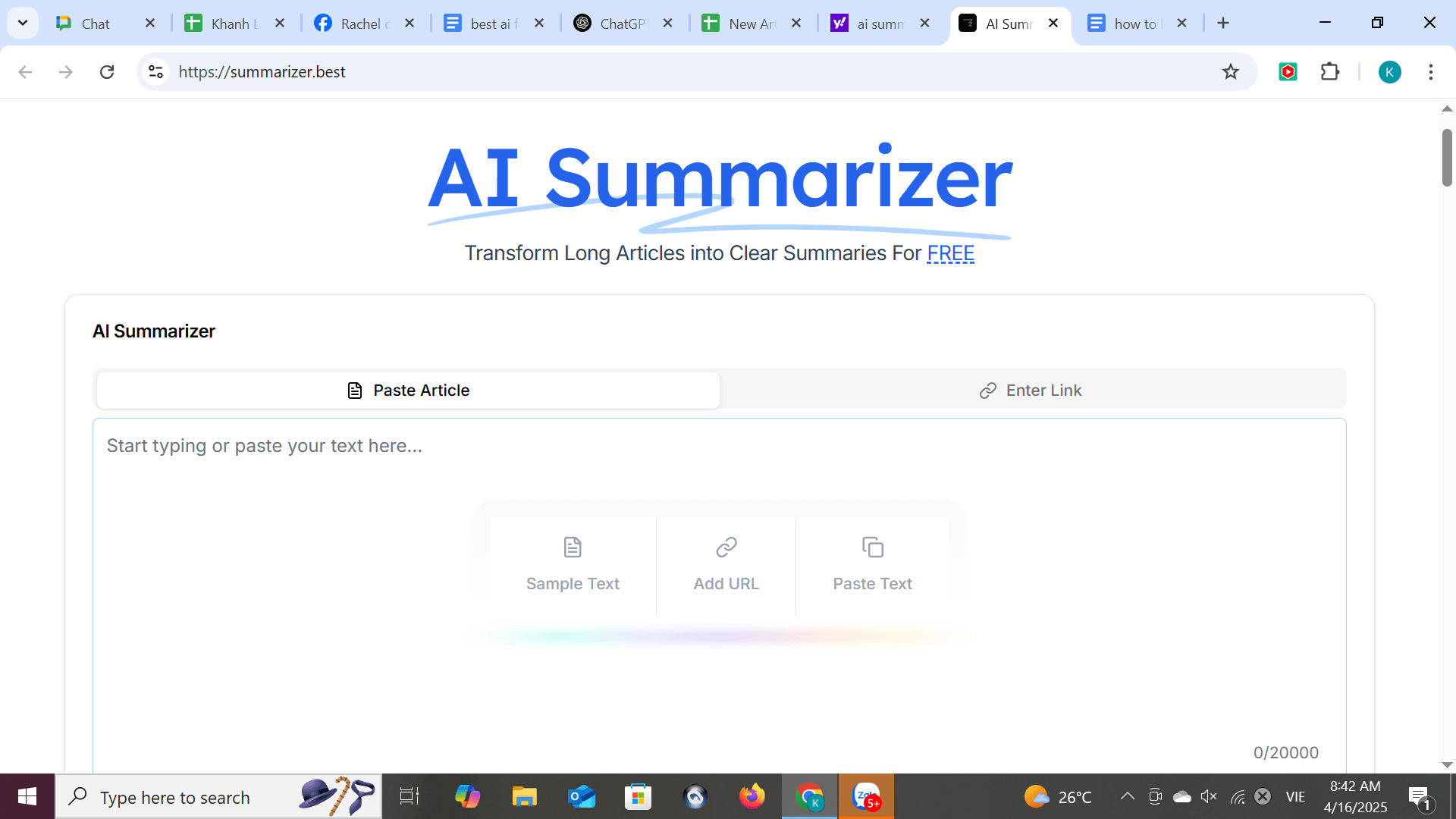
AI Summarizer Homepage
Scholarcy
Scholarcy is an online research paper and article/book chapter summarizer that utilizes artificial intelligence to understand your needs quickly and produce summaries of the key findings in a flashcard format. Scholarcy is respected as one of the top AIs to summarize a research paper, especially for academic purposes.
Key Features:
- Summary Flashcards: Scholarcy generates flashcards that offer a summary of key elements of your document—key ideas, abstracts, and summaries. It’s great for quick assessment and making sure that comprehension of otherwise difficult-to-understand documents.
- Summary by Section: Users can access certain sections of a research paper and only read the introduction, the methods, or just the findings.
- Summarized References: Where applicable, Scholarcy will locate and summarize references, even providing hyperlinks to open access articles from time to time.
- Merging Research Libraries: If you have a Zotero or Google Drive account to organize your research, Scholarcy will import from there to assist you in getting what you need.
| Pros |
Cons |
| ✅ Extracts references and citations |
❌ Learning curve for advanced features |
| ✅ Enables collaboration |
❌ Requires internet connectivity |
| ✅ Saves time with fast reading |
❌ Overwhelming for users seeking simplicity |
| ✅ Accessibility options |
❌ Resource-intensive on older devices |
| ✅ Regular updates |
❌ Can appear visually cluttered |
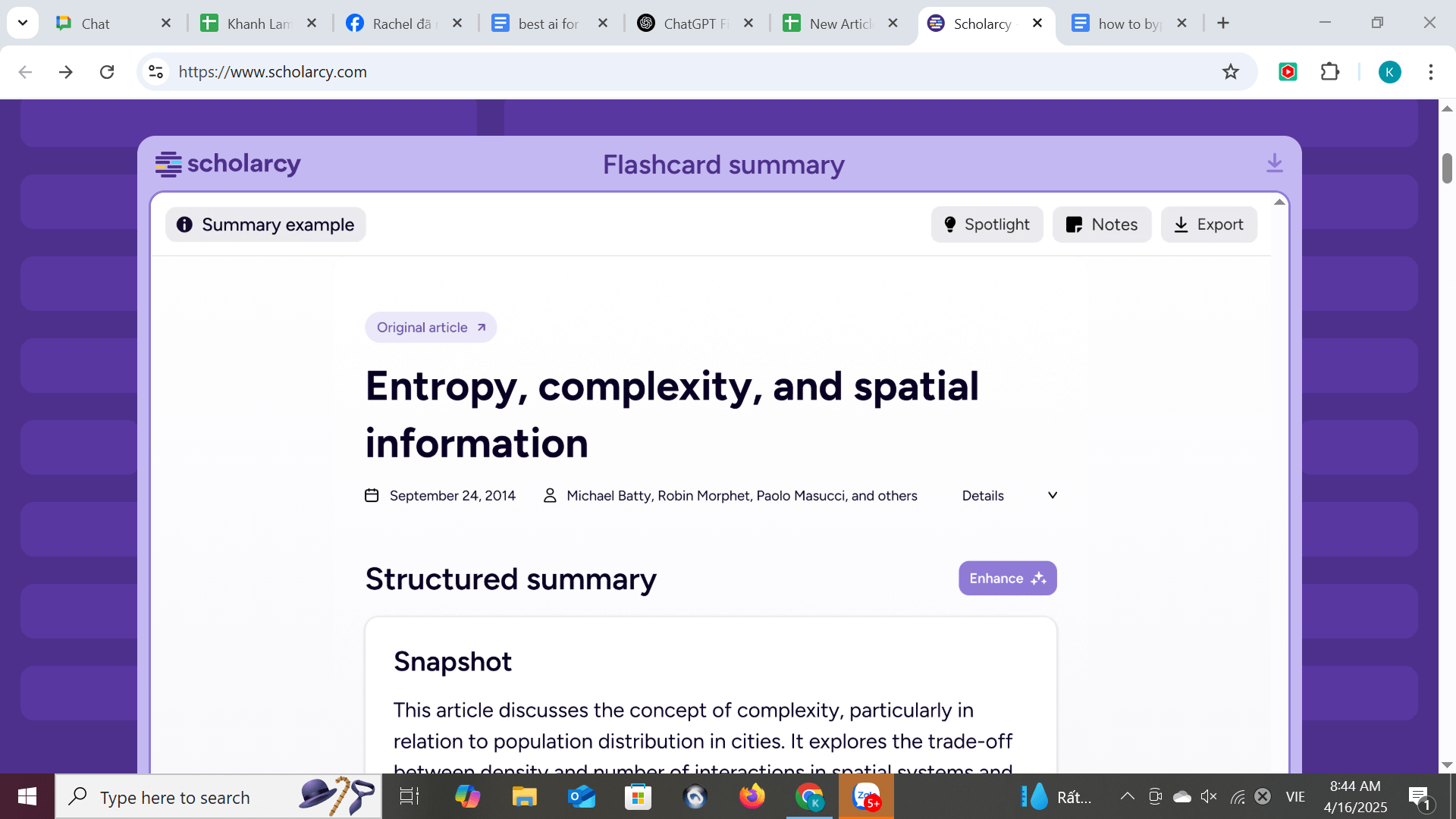
Scholarcy Summarizing Tool
Other AI Summarizing Tools
Looking for more than just the usual big five? These AI summarizers are also worth a look:
- TLDR This— A no-frills, user-friendly, online article and web page summarizer. Great for news articles, blogs, and research summaries.
- Summarizingtool.net— A no-fuss text summarizer in which you paste the text and select how short or long you want the summary to be. Great for research or pleasure.
- Resoomer— An article summarizer for argumentative and structured text, this software reads a text to understand its major concepts and summarizes accordingly in a linear fashion.
- Scribbr— The academic’s best site for anything and everything; not only does Scribbr summarize research papers, but it also has plagiarism checking, proofreading, and paraphrasing services.
- Quillbot Summarizer— Part of the Quillbot family, this uses AI technology to summarize large volumes of text and allows you to choose a key sentence summary or paragraph summary.
You may be interested in:
Discover 8 Best AI for Research for Academics and Researchers in 2025
How To Find Sources for A Research Paper AI References (2025 Guide)
5 Key Factors to Consider When Choosing AI For Summarizing Tools
Factors to keep in mind to choose the best AI for summarizing research papers are:
- Accuracy: AI is only as effective in generating an appropriate summary or output as its dependability and accuracy. The more accurate the AI is, the less time you’ll have to spend reworking or redrafting what it gives you.
- Customizability: A good AI platform would enable you to control its intensity of information and brevity so that whatever it provides you is custom-made to your needs.
- Integration: The tool must integrate into existing applications and platforms. The easier the integration, the less redundant time spent on shifting, which keeps people productive.
- Usability: The easier the interface, the better. If you have to stop what you’re doing to understand settings, then it’s not worth it.
- Cost: Understand whether this is a monthly subscription, a one-time fee, or pay-as-you-go. Cost should be commensurate with value and offered attributes.
Wrapping It Up
Whether you are a student or researcher pressed for time, or a knowledge worker buried under excessive amounts of literature, these best AI tools for summarizing research papers can enhance your ability to focus, save time, and revolutionize your research. Tried one of these tools already? Or have a favorite we didn’t mention? Share your thoughts in the comments now!
FAQs
2. How does an AI tool for summarizing work?
AI summary tools work via natural language processing (NLP) and machine learning models, which pull relevant information from longer works and present their findings in summary form.
4. Are AI research paper summarizers accurate?
Yes, most are accurate and pull significant points; however, when dealing with major publications, it’s always best to go back to the actual source to verify that all clarity and attribution are maintained.
